Vol 3 No. 44 TROPIC LIGHTNING NEWS October 28, 1968
Index
| Unit Page | Unit Page | Unit Page | Unit Page |
| 1/5 6 | 2/22 8 | 25th Avn Bn 1 | 3/4 Cav Photo 1 |
| 2/12 Photo 6 | 2/27 4 | 25th Avn Bn 8 | 3/22 6 |
| 2/14 6 | 2/27 Photo 4 | 25th DIVARTY 6 | 4/23 6 |
| 2/14 Photo 7 | 2/27 Photo 7 | 25th DIVARTY 8 | 588th Engr 6 |
| 2/14 Photo 7 | 2/27 Photo 7 | 3/4 Cav 1 | 7/11 Arty 6 |
| 2/22 1 | 25th Inf Photo 8 |
Fill Out & Return Absentee Ballot!
Chopper Crew Chief An Everyday Hero
By WO1 Donald Mattingly
CU CHI - Out of the war in Vietnam have come many heroes. The
single heroic acts of soldiers are recognized with medals and praise. But,
the day-to-day heroism of men doing dangerous but necessary jobs often goes
unnoticed by most.
One such everyday hero is perhaps the helicopter crew chief.
Warrant Officer Donald M. Mattingly, a chopper pilot with Company A, 25th
Aviation Battalion, knows the crew chief well and depends on his competence.
He has this to say:
"As each and every infantryman will tell you, the chopper is his
lifeblood. It delivers his supplies, takes out his wounded, and extracts
his fellow soldier in time of imminent danger.
"The man on the ground watches as the Huey comes in; piloted by,
I am sure, the equivalent of the daring men of World War I who flew against the
'Red Baron.' With enemy tracers streaking by the chopper, the crew
defies all to bring needed supplies to the ground unit.
"As the Hueys head for home, the infantryman says a quiet thanks
to the pilot.
"And yet, there is another man, less known and even less
glorified who should be included, for without this man, all the money and all
the aircraft available would be useless. This man is the crew chief.
"The crew chief is the man responsible for the aircraft being
operational. He sits in the left gunner's seat and shares the dangers of
each mission with the pilots.
"We call him a man but in reality he is an 18- to 20-year-old boy
fresh out of Advanced Individual Training (AIT). He is a boy who, for the
first time in his life is away from home. He is a boy who is on the
aircraft an hour before the pilot, insuring that all is well; the same boy who
rides shotgun on the M-60 machine gun when flying; the same boy who continues to
work on the aircraft when the mission is completed.
"And after he has finished work on the aircraft, this same boy
pulls guard duty, K.P., and does additional work in maintenance. It is a
misnomer to call this individual a boy because he matures fast and leaves as a
man.
"As a pilot who depends on the competence and judgment of the
crew chief, I wish to say to them: Thank you for a job well done."
NVA Meet 3/4 Cav On Tay Ninh MSR
By PFC Robinson Truitt
CU CHI - Shortly before dawn, an armored cavalry platoon of the 3d
Squadron, 4th Cavalry's A Troop engaged a reinforced company of North
Vietnamese regulars in a brief but fierce battle that left 21 enemy dead.
In addition, three enemy suspects were held by the cavalrymen in
the action 500 yards west of Phuoc My on an isolated section of the main supply
route to Tay Ninh.
After making a night move into the area, the armored personnel
carriers and a tank set themselves up in a herring-bone formation with each
vehicle pointing alternately to the left and right sides of the road. Rice
paddies bordered both sides.
Sergeant First Class William R. Yingling of Clarksville, Tenn.
radioed a negative situation report at 3:30 a.m. Ten minutes later, small
arms and rocket fire opened up on the column from behind rice paddy dikes on
both sides of the road.
Specialist 4 Minter A. Garvin of Macon, Ga. immediately fired an
illumination flare and continued firing them from his mortar track until the end
of the engagement. "If it hadn't been for Garvin," explained
Yingling, "we wouldn't have been able to see anything. We would have
been sitting ducks."
At one point, an RPG hit the upper right and corner of the loading
ramp of Yingling's APC and blew the hatch cover off, knocking the radio out
temporarily and throwing Yingling to the ground. No irrepairable damage
was done, however.
Around 4:00 a.m. helicopter gunships from the 3/4 Cav's D Troop
arrived and together with artillery fire from four different Tropic Lightning
batteries, provided support to the ground troops who were firing everything they
had into the rice paddies.
The battle raged for an hour and fifteen minutes with sporadic
small arms fire continuing until 5:30 a.m.
A sweep of the area after the battle revealed 21 enemy dead.
There was indication that the enemy had carried off several wounded. Three
detainees and several RPG launchers with ammunition, AK-47 assault rifles, 60mm
mortars, rifle grenades, demolition charges and miscellaneous equipment were
captured.
The suspects were found in water-filled spider holes, some as deep
as five feet, dug into the rice paddy dikes. They had been completely
submerged in the water throughout the night and had remained undetected by
breathing through straws.
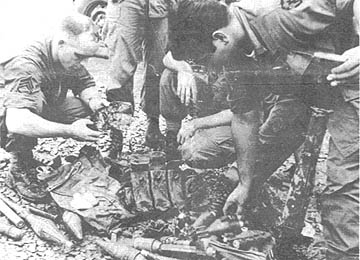 |
NVA WEAPONS captured by the 3d Squadron, 4th Cavalry, are inspected by Staff Sergeant Francisco A. Salas (standing) of Laurel, Md., and Sergeant First Class Alvia M. Cooper of Sandersville, Ga. (PHOTO BY PFC ROBINSON TRUITT) |
Triple Deuce, Airpower Rip Cong
CU CHI - Two days after returning from deployment near Saigon, the
2d Battalion (Mechanized), 22d Infantry, commanded by Lieutenant Colonel James
Samon of Springfield, Va., was involved in a late afternoon battle two miles
north of Go Dau Ha. Fifteen enemy were killed by the Triple Deuce
Infantrymen.
The action started when one squad found 'Charlie.'
Fighting eventually involved two Triple Deuce companies and the battalion's
scout platoon.
A squad from Company C was reconning a road when they were pinned
down by heavy enemy fire. First Lieutenant William B. Canion, 1st Platoon
leader from San Antonio, Tex., moved up the remainder of the platoon to support
his engaged squad.
Then, Captain James Curry, C Company commander from Columbia, S.C.,
deployed the remainder of his company against the entrenched enemy.
As the 2d Platoon, led by First Lieutenant Michael Andrews of
Jacksonville, N.C., advanced along the road, they received heavy fire from their
left flank and turned to face the enemy. Meanwhile, the 3d Platoon, under
First Lieutenant Stephen A. Worrell, from Atlanta, Ga., swung around to the
right side and came up behind the 1st Platoon.
Loss of a radio early in the battle hampered the 2d Platoon, until
a soldier from the 3d Platoon low crawled 150 meters under heavy enemy fire to
bring up the badly needed radio.
By this time tactical air support and helicopter gunships were on
station over the battle area. Worrell was in the best position to observe
the enemy and took tactical control of the aircraft. He directed their
fire at the fortified positions from which the enemy were firing heavy machine
guns at the Triple Deuce soldiers.
While C Company engaged the enemy, Company A, led by Captain Harvey
Holten from Chicago, Ill., and the battalion Scout Platoon, led by First
Lieutenant John Weldon moved into blocking positions.
As dismounted troops from A Company advanced, they came under heavy
enemy fire.
Sergeant John M. Bradley from Mobile, Ala., ran out to bring back a
wounded medic. While he was in front of the enemy positions, an enemy
bullet drilled his canteen. For the remainder of the action, Bradley, in
addition to directing his squad, filled in as a medic.
When the dismounted elements made contact, the armored personnel
carriers of the Scout Platoon and A Company rumbled up to support the engaged
soldiers. Blazing away with their machine guns and rifles the Triple Deuce
infantrymen forced the enemy to flee just before dusk.
During the engagement fifteen enemy soldiers were killed. A
sweep of the battle area the following day revealed an extensive bunker complex
which was destroyed.
Page 2 TROPIC LIGHTNING NEWS October 28, 1968
Decorated
| BRONZE STAR MEDAL (HEROISM) | |
|
2LT Dennis J. Swenie, Co A, 2d Bn, 22d Inf SSG Roger Hardemen, Co D, 65th Engr Bn SSG Robert E. Nelson, Co D, 3d Bn, 22d Inf SSG Dale W. Porter, HHB, 2d Bn, 77th Arty SGT Floyd C. Mc Mahan, Co A, 2d Bn, 22d Inf SGT Paul L. Steinhilber, HHB, 2d Bn, 77th Arty SGT Jack Hannula, Co A, 3d Bn, 22d Inf SP5 William M. Stumpp, HHB, 7th Bn, 11th Arty SP5 Robert J. Fitzgerald, A Trp, 3d Sqdn, 4th Cav SP4 Edward W. Nygren, Co A, 2d Bn, 22d Inf SP4 Johnny L. Howard, Co A, 2d Bn, 22d Inf SP4 J.E. Thompson, Co A, 2d Bn, 27th Inf SP4 Herbert Bellamy, Co A, 2d Bn, 27th Inf SP4 Edwin A. Jiminez, Co A, 2d Bn, 27th.Inf SP4 Larry E. Wisecarver, Co A, 2d Bn, 27th Inf SP4 Everett Myers, Co A, 2d Bn, 27th Inf SP4 Gerald P. Coffey, Co A, 2d Bn, 27th Inf SP4 William Tunstall, Co A, 2d Bn, 27th Inf SP4 Gilbert Ca,laf, Co A, 2d Bn, 27th Inf SP4 Paul L. Lawson, Co A, 2d Bn (Mech), 22d Inf SP4 Perry A. Sheridan, Co B, 3d Bn, 22d Inf SP4 John J. Michlitsch, Co A, 2d Bn, 22d Inf SP4 Syl D. Dew, HHT, 3d Sgdn, 4th Cav SP4 Danny R. Alvis, HHC, 3d Bn, 22d Inf SP4 Dennis Mueffleman, Co B, 1st Bn, 27th Inf SP4 Ranny Stephens, Co B, 1st Bn, 27th Inf SP4 Edwin J. Paprccki, Co A, 2d Bn, 22d Inf SP4 Edward L. Ostdick, Co C, 2d Bn, 22d Inf SP4 Tyrone Smith, Co C, 3d Bn, 22d Inf SP4 Joseph J. Demeo, Hq & Co A, 25th Med Bn SP4 Richard A. Dibacco, HHC, 3d Bde SP4 David H. Hansen, 25th MP Co SP4 John J. Haisch, Co B, 25th Sup & Trans SP4 Edwin D. Johnston, HHC, 3d Bde SP4 Steven Kedaj, A Btry, 2d En, 77th Arty SP4 Gary W. Oliver, HHC, 2d Bn, 22d Inf SP4 Lester W. Brown Jr., Co D, 2d Bn, 27th Inf SP4 James M. Williams, Co D, 2d Bn, 27th Inf SP4 Thomas M. Smith, Co D, 2d Bn, 27th Inf SP4 Darrel H. Smith, Co B, 1st Bn, 5th Inf SP4 Johan K. Paige, Co A, 2d Bn, 22d Inf SP4 Willie J. Maull, Co A, 2d Bn, 34th Armor SP4 Earl D. Joyner, Co D, 2d Bn, 27th Inf SP4 Roger Van Rensselaer, Co F, 50th Inf SP4 Ronald D. Landes, Co D, 2d Bn, 27th Inf |
SP4 Donald A. Klug, Co D, 2d Bn, 27th Inf SP4 Kenneth J. Phillips, Co D, 2d Bn, 27th Inf SP4 Michael F. Koppinger, Co D, 2d Bn, 27th Inf PFC John C. Jurgilas, HHB, 2d Bn, 77th Arty PFC John R. French, Co C, 3d Bn, 22d Inf PFC Karl Kaiden, Co C, 3d Bn, 22d Inf PFC William R. Tarkington, Co A, 2d Bn, 22d Inf PFC Bobby W. Lamb, Co A, 2d Bn, 22d Inf PFC Alonzo L. Norwood, Co A, 2d Bn, 22d Inf PFC Roger P. Rost, Co A, 2d Bn, 27th Inf PFC Barry L. Aumiller, Co A, 2d Bn, 27th Inf PFC Joseph Summers, Co D, 4th Bn, 9th Inf PFC Willie Hackett, Co A, 2d Bn, 27th Inf PFC Richard Devins, Co A, 2d Bn, 27th Inf PFC Richard J. Stoner, Co A, 2d Bn, 27th Inf PFC Jorge S. Torres, Co A, 2d Bn, 27th Inf PFC Larry Tillman, Co A, 2d Bn, 27th Inf PFC Richard L. Buddemeyer, Co A, 2d Bn, 22d Inf PFC William C. Mullee, Co B, 1st Bn, 27th Inf PFC Paul E. Rechin, Co B, 1st Bn, 27th Inf PFC Antonio D. Martinez, Co A, 2d Bn, 22d Inf PFC William T. Baiorek, Co B, 2d Bn, 22d Inf PFC Kenneth F. Blakely, Co D, 2d Bn, 12th Inf PFC Ronald Hedrick, Co A, 2d Bn, 22d Inf PFC Thomas W. Burrell, Co A, 2d Bn, 22d Inf PFC Thomas R.'Broughton, Co D, 4th Bn, 9th Inf PFC Frederick J. Jolly, Jr., Co B, 4th Bn, 9th Inf PFC Ronald J. Wicks, Co D, 2d Bn, 27th Inf PFC James Marshall, Co C, 2d Bn, 27th Inf PFC John W. Manner, Co A, 1st Bn, 27th Inf PFC John Tackett, Co D, 1st Bn, 27th Inf PFC Julius Johnson, Co C, 2d Bn, 27th Inf PFC Carroll E. Richard, Co A, 1st Bn, 27th Inf PFC Russell A. Gardner, Co A, 1st Bn, 27th Inf PFC Buddy Edwards, Co A, 1st Bn, 27th Inf PFC Gary L. Pherson, Co Am 1st Bn, 27th Inf PFC John H. G. Rose, Co A, 2d Bn, 34th Armor PFC Danny L. Rallens, Co A, 2d Bn, 34th Armor PFC Clifford R. Roberts, Co D, 2d En, 27th Inf PFC Fernando V. Garza, Co D, 2d Bn, 27th Inf PFC Francis L. Corbin, Co A, 4th Bn, 9th Inf PFC Harold L. Portwood, Co D, 1st Bn, 27th Inf PFC James L. Harris, Co B, 1st Bn, 5th Inf PFC Clarence S. Smith, Co B, 4th Bn, 9th Inf PFC Robert Rubio, Recon, 4th Bn, 23d Inf |
Vote - You Fight For It! Return Ballots Now
|
TO THE MEMBERS OF THE ARMED FORCES: |
MESSAGE FROM FORMER PRESIDENT TRUMAN TO THE ARMED FORCES: Every one of you as a member of the Armed Forces is serving our country in a special way. You are keeping America safe and secure. One could hardly ask you to do more than that. But I'm going to anyway. As a former soldier, and as a former Commander-in-Chief, but most of all, as just a private American citizen, I'm going to ask you to carry out a special duty. That is to vote in next month's national elections. It doesn't matter where you are stationed, if you wear an American uniform you have the right and the obligation to cast your ballot. There are a lot of countries where a citizen can't vote. Or, if he can vote, it really doesn't mean anything. That's isn't true of America. We must never let it become true in America. The way to keep it from happening is for you and me and all of us to vote. I'm asking you to do just that. Harry S. Truman |
Federal Surcharge May Mean Higher Payments For Soldiers
U.S. Army finance officials have pointed out that federal income
tax deductions from the monthly paychecks of Army members may not be enough to
cover a soldier's total annual federal tax liability.
This situation means, in effect, that a soldier may be faced with a
larger than usual federal income tax payment due when he files his 1968 income
tax return after the end of this year. It is a result of the new surcharge
on individual federal income taxes.
The U.S. Army Finance Center suggests that Army personnel may wish
to increase voluntarily the amount of money withheld monthly, for federal taxes.
This will decrease the amount they will owe when they file their 1968 tax
returns.
To increase the amount of tax withheld during the year, the
taxpayer has the option of claiming fewer exemptions or authorizing additional
amounts to be deducted from his pay.
The new surcharge is what is commonly called the 10 per cent
federal surcharge on individual income taxes. Actually, for most taxpayers
the surcharge will amount to 7.5 per cent for 1968, because the tax did not take
effect until April 1. In the lower brackets, the surcharge ranges from
zero to 7.5 per cent.
The additional tax was established by "The Revenue and
Expenditure Control Act of 1968." The same law also prescribes new rates
of withholding tax and does not permit the employer to exercise any discretion
in determining the amount to be withheld.
Finance officials point out two problems with respect to satisfying
the income tax liability through the prescribed withholding tax structure:
• The increased withholding rates began July 1, although the
surcharge took effect three months earlier.
• The withholding tax tables are constructed so that in the
higher income brackets the amount of withholding is not sufficient to satisfy
the income tax liability. This problem, which has existed as long as there
has been a withholding tax, was further aggravated by the surcharge. (ANF)
The TROPIC LIGHTNING NEWS is an authorized publication of the 25th
Infantry Division. It is published weekly for all division units in the Republic of
Vietnam by the Information Office, 25th Infantry Division, APO San Francisco
96225. Army News Features, Army Photo Features, Armed Forces Press Service and Armed
Forces News Bureau material are used. Views and opinions expressed are not necessarily
those of the Department of the Army. Printed in Tokyo, Japan, by Pacific Stars and
Stripes.
MG Ellis W. Williamson . . . . Commanding General
MAJ Andrew J. Sullivan . . . Information Officer
2LT Don A. Eriksson . . . . . . Officer-in-Charge
SP4 Bill Berger . . . . . . . . . . . Production Supervisor
SP4 Stephen Lochen . . . . . . Editor
SP4 Tom Quinn . . . . . . . . . . . Asst. Editor
Page 3 TROPIC LIGHTNING NEWS October 28, 1968
WHEN YOU ETS -
- Benefits Are Waiting
Your Schooling From GI Bill
THE EDUCATIONAL features of the peacetime GI Bill are approaching
World War II and Korea enrollment figures in popularity among veterans.
Significantly, 22,000 active duty members are benefiting from the
359,800 GI Bill allowances being paid as of January 31, according to Veterans
Administration officials. The 22,000 active duty members and 337,800
veterans are drawing the funds to finance education in the field of pilot
training or to pursue high school and college courses on a full and part-time
basis. And, according to VA, a greater interest in flight training has
been shown by active duty personnel than veterans.
Since the peacetime GI Bill became law on June 1, 1966, nearly
671,000 veterans of service since Jan. 31, 1955, have entered training.
Right now. the Veterans Administration estimates it is helping 360,000 men and
women.
The VA reached its peak enrollment for the World War II GI Bill in
November, 1947, when 2.5 million were enrolled in education and training
programs. The peak for Korea GI Bill benefits was reached in March, 1957,
with a 764,000 training enrollment.
From these two peaks, GI Bill enrollment dropped to 8798
beneficiaries in January, 1965 - the last month in which wartime GI Bill
benefits were paid until Congress enacted the peacetime GI Bill in early 1966.
President Johnson has proposed re-opening GI Bill education
benefits to veterans with lapsed World War II or Korea GI Bill eligibility who
volunteer to teach in ghetto and rural areas.
For every month they agree to serve, the government would permit
then to draw GI Bill allowances at the post-Korea rates.
In addition, the Presidential request would permit veterans -
wartime and peacetime veterans - who stay in public work beyond two years to
build-up additional GI Bill eligibility. They wouid be permitted to
build-up an additional 36 months school aid at the rate of one day's school
aid for each day of employment.
Also, the Administration is pushing for a change in the Veterans
Vocational Rehabilitation program to permit veterans to pursue studies on a
part-time as well as a full-time basis.
The word "school" in the GI Bill refers not only to
universities and colleges, but also includes reputable public and private
business and trade schools, professional and technical institutes, flying
schools, and home study schools with the exception of flight training.
Active duty personnel, however, are not eligible for other
education and training provisions such as job training and farm cooperative
courses.
The increase in the number of veterans pursuing below college
studies is attributed to recent changes in law which permits "educationally
disadvantaged" veterans to take high school or refresher courses without loss
of GI Bill entitlement. GI Bill eligibility is not counted until a veteran
enters post-high school training.
A single veteran enrolled full time in an approved course can draw
$130 per month under the GI Bill. If he has one dependent, his allowance
is $155. With two dependents, he can receive $175. The allowance is
increased $10 for each additional dependent.
The formula for figuring GI Bill entitlement is simple: One
month's educational assistance for each month spent on active duty up to 36
months of aid. This means, a serviceman must remain on active duty for
three years to build-up maximum entitlement. The services - particularly
the Army - are finding this requirement a valuable gimmick in getting draftees
in the "hard-skills" (aircraft mechanics, signal specialists) to volunteer
for an extra year of active duty.
A serviceman is eligible for GI Bill educational assistance while
on active duty if he has had two continuous years of service. The
serviceman, however, is not eligible for any additional allowance for his
dependents like the veteran student. He can draw up to $130 monthly
towards payment of tuition costs.
The allowance for a correspondence course is based upon the cost of
tuition and fees, prorated by the number of lessons completed by the student and
processed by the school. A directory of accredited home study schools and
listings of the wide variety of subjects they teach can be obtained on request
from the National Home Study Council, 1601, 18th St. NW, Washington, D.C. 20009.
Some veterans prefer to hold a job and go to school part time.
Allowances are scaled proportionately for these students. For instance, a
man attending college half time can draw $60 a month under the GI Bill if he is
single; $75 if he has one dependent; $85 if he has two; and $5 more for each
additional child.
Veterans also can earn while they learn through approved apprentice
or on-the-job training. They receive practical training for specific job
objectives, as well as supplemental related instruction. Job training may
be taken only on a full-time basis. In addition to the wages he earns, the
veteran receives an education allowance.
During his first six months of job training he can draw $80 monthly
if he is single; $90 with one dependent; or $100 with two dependents. No
additional allowances are made for more than two dependents. The
allowances are reduced proportionately for succeeding six-month training
periods.
Allowances for flight training are now possible under the GI Bill,
but they are not just for the man who thinks it would be fun to learn to fly.
The would-be pilot is cautioned to check carefully into his eligibility before
he commits himself to flight lessons.
Flight school courses must be approved by the FAA and appropriate
state authority.
Farm cooperative courses are being set up under the GI Bill for
veterans serious about a career in some branch of agriculture. The student
spends 12 hours a week attending courses that relate to the kind of agricultural
work in which he is engaged.
He must be employed on a farm or ranch on a year-round basis.
Seasonal crop work will not qualify for this cooperative training.
Applicants for GI Bill education benefits must have served on
active duty continuously for at least 181 days, some of them after Jan. 31,
1955. Veterans who were released or discharged for a service-connected
disability before they served 181 days also can qualify for assistance.
Broken periods of service cannot be combined to meet the 181-day
requirement. The basic period must be continuous.
Time spent in active duty for training in the Reserves or National
Guard does not count in the 181-days. This includes enlistees in the
so-called six-month Reserve program. Nor can a veteran count time spent as
a cadet or midshipman in a service academy, or taking full-time courses at a
civilian school at government expense.
Active duty personnel are eligible for GI Bill benefits if they
meet the 181-day and discharge requirements applying to veterans. The
discharge requirement is waived, however, if a serviceman has two or more years
of active duty behind him. In such cases, broken periods of service
totaling 730 days may be combined.
Forms for applying for GI Bill benefits can be obtained from base
education offices, schools, VA offices and from representatives of veteran's
organizations. (Army Times)
Veteran Has Edge On Civil Service
President Johnson has ordered the Civil Service Commission to
provide Vietnam veterans with employment under "transitional appointments"
in grades 1 through 5 without taking a competitive examination.
Under an executive order signed Feb. 9, "qualified" Vietnam
veterans who have completed less than one year of education beyond high school,
meet all other civil service requirements and served on active duty in the armed
forces on or after Aug. 5, 1964, will be eligible to enter federal employment
provided they agree to pursue a fulltime or part-time educational program under
the GI Bill.
"For those with the necessary initiative and ability, this new
program - together with the GI Bill - offers a chance for both further education
and better jobs," the President said.
According to the executive order, those who apply for an
appointment and are hired will be subject to:
(1) The satisfactory performance of assigned duties;
(2) The satisfactory completion, within a reasonable time set by
the Civil Service Commission, of not less than one year of a full-time approved
educational or training program, the equivalent thereof, or two years of
full-time approved education or training when an employee has not completed high
school or its equivalent.
Personnel eligible for appointment must be hired within one year
after separation from the armed forces, a year following release from
hospitalization or treatment immediately following separation from the armed
forces, or a year after the effective date of the executive order, whichever is
later.
One Stop Veteran Centers Give You Advice And Aid
WASHINGTON - By mid-March, the Veterans Administration expects to
have 20 "one-stop" service centers in operation giving personal attention
and counsel on all benefits to returning service men.
The first 10 Veterans Assistance Centers were scheduled to be in
operation on February 19. These cities are New York, Chicago, Los Angeles,
Philadelphia, Detroit, Cleveland, Washington, D.C., San Francisco, Boston and
Atlanta.
Veterans Centers are scheduled to be in operation shortly
thereafter in the following 10 cities -Baltimore, Milwaukee, Houston, St. Louis,
Pittsburgh, San Antonio, New Orleans, Indianapolis, Phoenix and Newark.
Based on the experience gained in these 20 pilot locations, the VA
may establish Veterans Centers in other cities.
"Personalized attention" will be the motto in the Centers,
officials told Army Times.
Under one roof, a veteran will be able to receive personal
attention and advice on all the benefits the law provides him - from housing to
health, from education to employment.
Each Veterans Center will be headed by a VA contact officer and be
permanently staffed by representatives of the Civil Service Commission, the
Labor Department's Veterans Reemployment Office, and the local veterans
employment office.
In addition to the permanent staff, assistance will be available to
returning veterans who request it from the Office of Economic Opportunity, the
Justice Department, Small Business Administration, Health, Education and
Welfare, and the Department of Housing Urban Development.
The VA is also seeking participation in these cities by agencies
engaged in helping veterans, such as the veterans' groups.
The VA plans to personally contact each returning veteran,
informing him of the many services available at the Veterans Assistance Centers.
In addition, VA staffers plan to personally call on veterans who are unable to
come to an Assistance Center because of disability or who have a particular
need. (Army Times)
Page 4-5 TROPIC LIGHTNING NEWS October 28, 1968
Four Deuce Mortar Team Tackles Trouble
CU CHI - Specialist 4 Terry Wimberly, better known as
Wimpy, was sitting on top of his bunker singing 'Little Green Apples.'
He is a great fan of Roger Miller.
Private First Class John Tollel had just finished humping rounds to
replenish what the four-deuce mortar team had used the night before. He
started to take a swig of water from his canteen when the cry 'FIRE MISSION'
came from someone in the fire direction center (FDC).
Sergeant Clinton Perkins, 27, of Louisiana, Mo., carefully but
rapidly put down Short Round, the team's little puppy, and charged toward the
phone.
Mac - Specialist 4 Kenneth McFarland, 21, of Big Lake, Tex.- was
cleaning the Wolfhound crest on his bush hat and thinking that his 10 months
with the 2d Battalion, 27th Infantry, had been pretty good. Sure, things
had been rough at times, but they could have been worse. He threw his hat
down and moved out.
Less than five seconds after the cry from the FDC rang out, Wimpy
had his shoulder against the tube ready to move it into position when Perkins
gave the deflection and elevation. As assistant gunner he helps Mac, who
had slapped on the sight and had his eye glued to it.
Tollel, 22, had quit thinking about his wife in London, Ohio, and
had two rounds out of the black canisters. He was ready to cut the right
charges as soon as Perkins hollered.
The four soldiers were tired. They had fired illumination
rounds for a total of four hours the night before, and that along with the 105mm
howitzers 50 feet away didn't allow for much sleep. They didn't know
if they were firing on spotted enemy troops or giving direct support to a
Wolfhound patrol, but they were ready.
For some reason there was a long wait for Perkins to sound off.
Wimpy stood up to relax and that's when it came.
"Deflection 2375! Elevation 415! Charge 25!"
Mac and Wimpy put their weight together to move the 300-plus pound
tube. Then they made the precision alignment necessary. In three
seconds it was aimed. Tollel had ripped off the charges, that look like
slabs of Swiss cheese, to get down to charge 25. They can fire from charge
seven up to forty-one. The ammo bearer has to work fast and accurately.
Tollel had been in country only two months but had plenty of experience in that
time. The team fires an average of 2,500 rounds per month.
It seemed as if he hadn't even finished cutting the second charge
when he had both rounds in his hands and was headed for the tube.
Wimpy took the rounds and put one on his left shoulder and wrapped
his right hand tightly around the other.
When Perkins sang out 'hang it,' Wimpy lifted the round up so
the firing pin was just inside the tube.
Mac and Perkins plugged their ears while Tollel tried to plug his
and cut the charges on two more rounds at the same time.
Wimpy's arm started to quiver a little as the command to fire was
long in coming. The four-deuce heavy explosive round weighs about 40
pounds.
They waited for the command. They had waited thousands of
times before. One night in late August this team fired more than 200
rounds of illumination for a Wolfhound patrol during an eight-hour fight.
During Tet they fired 450 rounds of heavy explosive during the course of one
night.
"FIRE" yelled Perkins. In a flash, Wimpy, the 22-year-old
assistant gunner from Phoenix, Ariz., dropped the round down the tube, squatted
down to plug his ears then popped back up to hang the next round.
Nine more rounds were fired, and the fire mission was over.
This one was a simple mission. Some of them are rough.
When enemy rockets and mortars start crashing into the area, the team doesn't head for
the bunker - they head for the gun to start firing counter mortar. And
they are effective at it.
Sometimes there is a misfire - the round is dropped into the tube
but fails to fire. Then things get tense. Either the round is stuck
part way or has hit bottom and failed to fire.
Mac first kicks the tube to try to dislodge the stuck round.
If the round again fails to fire, the tube is quickly broken down and the dud
round is dumped out. Speed is essential for men's lives may depend on
it.
When they are firing large charges the tube is literally driven
into the ground. Then it has to be dug out and realigned. Again it
must be done quickly - even in the middle of a fight.
Everyone in the team is cross-trained to do all of the jobs.
Tollel knows as much about sighting the tube as Mac does.
Wimpy, Mac, Tollel and Perkins - a closely knit, extremely
efficient four-deuce mortar team that is proud of its work. These men are
the artillery of infantry, a hard working team that can pull their buddies in
the battalion out of scrapes.
|
Story And Photos By |
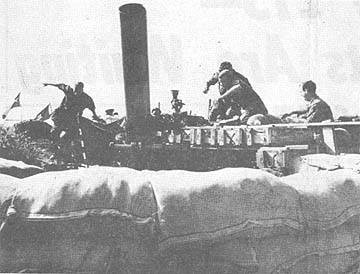 |
"FIRE MISSION" - When those two words are yelled everybody moves - and fast. From left: Private First Class John Tollel, Sergeant Clinton Perkins (partially hidden), Specialist 4 Kenneth McFarland, and Specialist 4 Terry Wimberly. |
| LIFE OR DEATH ACCURACY - Specialist 4 Kenneth McFarland of Big Lake, Tex., critically sights in the gun as Wimpy moves the 300-plus pound tube. Even if it is chow time when a mission comes in, everything is dropped and the team rushes to their firing positions. | 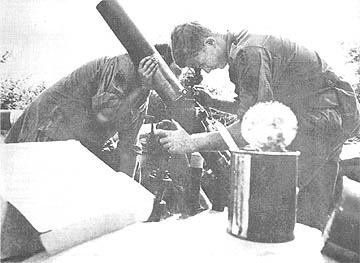 |
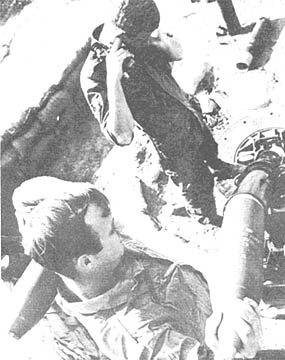 |
HANG IT - Specialist 4 Terry Wimberly "hangs" a round waiting for the command to fire as Specialist 4 McFarland, the team gunner, plugs his ears in anticipation of the blast. |
| DEFLECTION 2375! - Sergeant Clinton Perkins of Louisiana, Mo., the squad leader of the team, passes on the firing information from the fire direction center. | 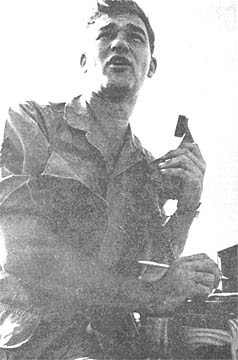 |
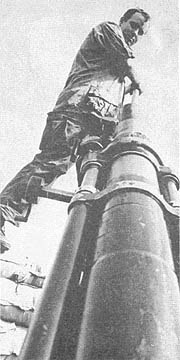 |
KEEPING IT CLEAN - Specialist Wimberly, the assistant gunner from Phoenix, Ariz., cleans the bore of the four-deuce tube. The 4.2 inch mortar team is part of the 2d Battalion, 27th Infantry Wolfhounds. |
| TOTING A LOAD - Carrying four rounds, weighing 40 pounds each, Private First Class John Tollel from London, Ohio, resupplies the tube after a fire mission. | 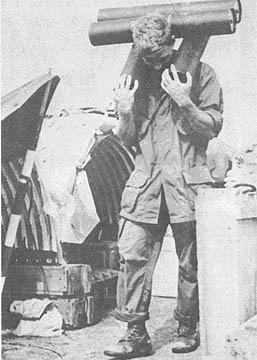 |
|
Deadly Team - |
Page 6 TROPIC LIGHTNING NEWS October 28, 1968
DIVARTY Team Work, Timing Route Out NVA Battalion
TAY NINH - The coordination of all the elements of Division
Artillery resulted in the routing of an estimated battalion-sized NVA force
eight miles southeast of Tay Ninh on Highway 26.
Warrant Officer Mark D. Mitchell piloted an OH-23 light observation
helicopter from DIVARTY Aviation as Lieutenant Colonel Forest E. Pierce,
commander of the 7th Battalion, 11th Artillery, and Sergeant Major William
Clevenger directed helicopter gunships, Air Force Super Sabre jets and
devastating artillery barrages on the enemy.
During eight hours in the air, the trio also make numerous
low-level passes firing their M-16's at the enemy.
The DIVARTY ship was enroute to a contact involving elements of the
4th Battalion, (Mechanized) 23d Infantry when Mitchell, from La Puente, Calif.,
spotted what he believed to be an enemy 12.7mm anti-aircraft site.
After several low-level passes, the sighting of the gun was
confirmed. It was set in a crater and heavily camouflaged with twigs and
foliage.
The trio marked the area with smoke, and Huey Cobra gunships
peppered the area with rockets and minigun fire. Pierce, from Leavenworth,
Kans., called in 105mm artillery fire from Battery C, 7th Battalion, 11th
Artillery commanded by Captain Harry K. Jowers.
The artillery fire from Fire Support Base Rawlins along with the
gunships tore up the area causing several NVA to scatter into the open.
Pierce and Clevenger then passed through at tree-top level firing
clip after clip from their M-16's. Although receiving contact small arms
fire and a heavy blanket of automatic weapons fire, the two, with the aid of
Mitchell's adroit maneuvering of the 'bubble' aircraft, kept the enemy
scattering through the woodline.
Coordinating with the artillery forward observer, First Lieutenant
James Q. Turner, of Huntington, N.Y., who was on the ground with the infantry
unit, the trio called in air strikes on the fleeing enemy.
At the same time, a convoy secured by the 1st Battalion
(Mechanized), 5th Infantry, was moving up Highway 26 from Dau Tieng to Tay Ninh
when the NVA suddenly opened up on them with machine gun, RPG and small arms
fire.
Pierce and the battalion sergeant major again placed suppressive
artillery fire from the unit at Rawlins on the enemy positions.
Heavy anti-aircraft fire from additional enemy positions that had
been heavily camouflaged began flying at the chopper. Pierce adjusted
artillery into the immediate area, firing pinpoint, danger-close fires on the
enemy.
As round after round of 105mm shells rained in, the enemy broke
contact and fled into the temporary security of a nearby rubber plantation.
A sweep of the area the following day disclosed 40 NVA bodies.
| RAINSOAKED AND WEARY - An infantryman rests during a break in a combat sweep by units of the 2d Battalion, 12th Infantry. Specialist 4 Vincent Dimarzo of Bayshore, Long Island, N.Y., was taking part in an operation with the 3d Brigade unit several miles northwest of Saigon. | 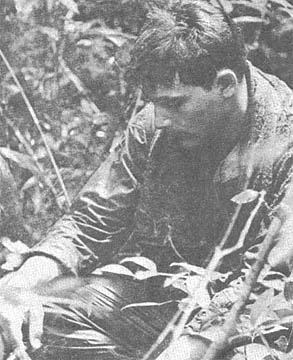 |
588th Expects To Cash In On Civilian Reward Program
TAY NINH - Efforts by the 588th Engineer Battalion to keep the road
net around Tay Ninh cleared of enemy mines and booby-traps are being aided by a
recently initiated civilian cash reward program. The program is expected
to pay big dividends in lives and eouipment saved.
On a recent trip along Highway 26, part of the Tay Ninh to Dau
Tieng military supply route (MSR), First Lieutenant Kenneth M. Snead, 21, the
588th's intelligence officer, distributed leaflets to the local civilians who
live and work along the road. The leaflets tell of rewards given for enemy
weapons turned in or for information leading to the location of weapons.
In addition, rewards are given for information on the location of mines or
booby-traps.
Accompanying Snead of Dunedin Beach, Fla., was the 588th's
interpreter, ARVN Sergeant My Lam, who helped hand out the leaflets and
explained their meaning to those who couldn't read.
One old farmer, working his field with two water buffalo, took a
leaflet and started to move off. He was asked if he could read and said
no, but he would take it home and have his daughter read it.
Lam said that "farmers like him are in an ideal situation for
giving information on mines and booby-traps; they work their fields next to the
road each day and can easily tell if the VC have installed mines there."
As Snead handed the leaflets to a group of children, he remarked,
"We actually tend to have more luck with the children. They don't have
the inhibitions of their parents, and don't seem to fear the VC the way their
elders do. And being kids, they naturally will get around a lot and will
be very likely to find an arms cache while playing."
On the way back into Tay Ninh base camp after the day on the MSR,
Snead said: "If just one of the thousands of leaflets we have passed out
results in saving the life of one American soldier, then all the efforts that we
have put into this program will have been worthwhile, and we can call the
program a success."
PFC Gets Deer John From 4-Legged Friend
TAY NINH - A 400-pound deer with fire in his eyes and vines hanging
from its antlers crashed through a woodline, made a sharp 45 degree turn and
knocked Private First Class Daniel Bennett of Memphis, Tenn., out of action, but
not for long.
Bennett was on a 1st Brigade reconnaissance-in-force mission near
the Cambodian border northwest of Tay Ninh city with the 3d Battalion, 22d
Infantry.
"We had just started into the woodline when our point man on the
right flank seemed to stir up something," said Captain George Featherston, of
Houston, Tex. "All of a sudden there he was - the biggest deer I've
seen - and he was charging straight at Bennett.
"We were all so stunned that we couldn't react in time.
He knocked Bennett into an artillery crafter, and then tripped in himself,"
continued Featherston, commander of Company B.
"I was the sixth man in the file, and I just didn't know what
hit me," recalled Bennett. "They tell me that the deer just barely
missed me when he fell in the crater, but by that time I was out cold and
didn't know what was happening."
The deer climbed out of the crater and continued on its merry way.
Bennett was dusted off for treatment.
"This was the weirdest thing that ever happened to me," said
Bennett. "Other people get hit with AK rounds or water buffalo, but me,
I get run over by a deer. Everyone was laughing so hard at the hospital
back in Tay Ninh that they had a hard time treating me."
"As you can see, I'm back on the job none the worse for
wear," said Bennett, "but I'm keeping my eyes peeled for deer."
Rice Galore
CU CHI - One of the largest rice caches uncovered in the Cu Chi
area to date was found by Company A, 2d Battalion, 14th Infantry. Some
25,000 pounds of rice, apparently stored for VC and NVA use, was discovered in
Duc Hoa district.
The 12 ½ tons of rice was raw, partially bagged and
stockpiled in four hootches in the area.
A guard was put on the area by the Golden Dragon unit until
Vietnamese National Police arrived and ordered the VC provisions turned over to
the refugee center in Duc Hoa.
Captain John Mader, Alpha Company commander, reported that the area
has been under surveillance as a principal VC trail for some time.
Page 7 TROPIC LIGHTNING NEWS October 28, 1968
 |
| LISTENING FOR COMMANDS - Sergeant Anthony J. Strasavich, 21, from Sykesville, Pa., a squad leader with Company A, 1st Battalion, 27th Infantry Wolfhounds listens for commands from his platoon leader as the 2d Brigade company engages snipers in the Iron Triangle northwest of Saigon. (PHOTO BY SGT ROSS ROESSLER) |
Page 8 TROPIC LIGHTNING NEWS October 28, 1968
|
Lt. Gen. Mildren's Visit |
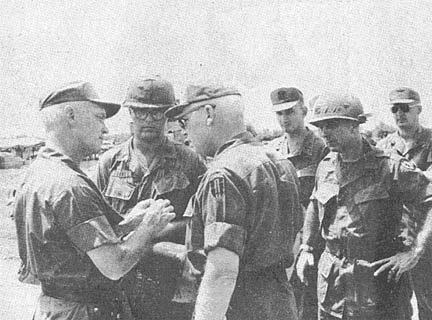 |
| LIEUTENANT GENERAL FRANK T. MILDREN, deputy commanding general, USARV, talks to Major General Ellis W. Williamson, commanding general, 25th Infantry Division, at Fire Support Base Pershing with First Lieutenant John J. Farley, XO, B Battery, 1st Battalion, 8th Artillery and Colonel Eugene M. Lynch, CO 2d Brigade. The battery fired direct fire missions during General Mildren's visit. (PHOTO BY MAJOR A. J. SULLIVAN) |
DIVARTY Civic Action Boasts Big Progress
CU CHI - Despite increased enemy activity in the Trang Bang
district, significant progress was made during September by Civic Action teams
from Division Artillery.
Noteworthy self-help projects completed by local residents in
cooperation with First Lieutenant Hansel H. Kipe, with MACV Advisory Team 43,
included the repair of damages to primary schools caused by enemy action; the
repair of a badly needled latrine facility at the Loc Du primary school, which
has several hundred students and the completion of a bunker for maternity
patients in the local hospital.
In addition, repairs were made on the roof of a hospital which had
been damaged by enemy terrorist activity. A project begun early in August
was completed in September also - the rebuilding of the Trang Bang district
civic action headquarters.
2-22 Fights VC Squad
CU CHI - In a short but sharp afternoon clash with an estimated
enemy squad, Company B, 2d Battalion (Mechanized), 22d Infantry, killed two Viet
tong and captured one AK-47 assault rifle.
The 3d Brigade unit was on a reconnaissance in force through wooded
terrain three miles east of Go Dau Ha when it came under enemy sniper fire.
Immediately, Captain Malcolm Waitt, B Company commander from Montgomery, Ala.,
turned the guns of his armored personnel carriers loose on the enemy positions,
flushing out ten Viet Cong.
While the enemy fled, two were cut down by the riflemen.
Cobra gunships from the 25th Aviation Battalion's Diamondhead Company then
arrived on the scene, pasting the enemy area with rocket and minigun fire.
The Triple Deuce company pushed into the area and uncovered an
enemy base camp of more than 30 bunkers. The riflemen also recovered the
weapon and web gear from the enemy dead.
Two days later, Triple Deuce along with two companies of Vietnamese
Marines swept back into the base camp to destroy the enemy positions and in the
process captured stockpiled enemy equipment, food, and ammunition.
The bottom half of page 8 contained an advertisement and order form for the 1967-68 Division Yearbook
Thanks to
Allan Azary, 1st Bn. (Mechanized), 5th Inf. for sharing this issue,
Kirk Ramsey, 2nd Bn., 14th Inf. for creating this page.
This page last modified 8-12-2004
©2004 25th Infantry Division Association. All rights reserved.